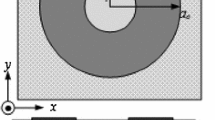Abstract
Radial stubs are a superior choice over low characteristic impedance rectangular stubs in terms of providing an accurate localized zero-impedance reference point and maintaining a low input impedance value over a wide frequency range. In this paper, knowledge-based artificial neural networks are used to model the microstrip radial stubs. Using space-mapping technology and Huber optimization make the neural network models for radial stubs decrease the number of training data, improve generalization ability, and reduce the complexity of the neural network topology with respect to the classical neuromodeling approach. The neural networks are developed for design and optimization of radial stubs, which are robust both from the angle of time of computation and accuracy.
Similar content being viewed by others
REFERENCES
B. A. Syrett, “A broadband element for microstrip bias or tuning circuits,” IEEE Trans. Microwave Theory Tech., vol. MTT-29, pp.925-927, Aug. 1980.
F. Giannini, R. Sorrentino and J. Vera, “Planar circuit analysis of microstrip radial stub,” IEEE Trans. Microwave Theory Tech., vol. MTT-32, pp. 1652-1655, Dec. 1984.
F. Giannini, M. Ruggieri and J. Vera, “Shunt-connected microstrip radial stubs,” IEEE Trans. Microwave Theory Tech., vol. MTT-34, pp.363-366, March 1986.
F. Giannini, C. Paoloni and M. Ruggieri, “CAD-oriented lossy models for radial stubs,” IEEE Trans. Microwave Theory Tech., vol. MTT-36, pp.305-313, Feb. 1988.
Hafid Zaabab, Qi-Jun Zhang, and Michel S. Nakhla, “Device and Circuit-Level Modeling Using Neural Networks with Faster Training Based on Network Sparsity,” IEEE Trans. Microwave Theory Tech., vol. MTT-45, pp. 1696-1704, October 1997.
Q. J. Zhang, F. Wang and M. S. Nakhla, “Optimization of high-speed VLSI interconnects: A review,” International Journal of Microwave Millimeter-Waves CAD, pp.83-107, 1997.
Anand Veluswami, Michel S. Nakhla, and Qi-Jun Zhang, “The Application of Neural Networks to EM-Based Simulation and Optimization of Interconnects in High-Speed VLSI Circuits,” IEEE Trans. Microwave Theory Tech., vol. MTT-45, pp. 712-723, MAY 1997.
P. M. Watson and K. C. Gupta, “Development of knowledge based artificial neural network models for microwave components,” IEEE MTT-S Int. Microwave Symp. Dig., New York, NY: IEEE, 1998, vol.1, pp.9-12.
F. Wang and Q. J. Zhang, “Knowledge-based neural models for microwave design,” IEEE Trans. Microwave Theory Tech., vol. MTT-45,no. 12, pp.2333-2343, Dec. 1997.
John W. Bandler, Mostafa A. Ismail, Jose Ernesto Rayas-Sanchez, and Qi-Jun Zhang, “Neuromodeling of Microwave Circuits Exploiting Space-Mapping Technology,” IEEE Trans. Microwave Theory Tech., vol. MTT-47,no. 12, pp.2417-2427, Dec. 1999.
J. P. Vinding, “Radial line stubs as elements in stripline circuits,” NEREM. Record, pp.108-109, 1967.
J. W. Bandler, S. H. Chen, R. M. Biernacki, L. Gao, K. Madsen, and H. Yu, “Huber optimization of circuits: A robust approach,” IEEE Trans. Microwave Theory Tech., vol. MTT-41,no. 12, pp.2279-2287, Dec. 1993.
M. T., Hagan, and M. Menhaj, “Training multilayer networks with the Marquardt algorithm,” IEEE Transactions on Neural Networks, vol. 5,no. 6, pp.989-993, 1994.
Author information
Authors and Affiliations
Rights and permissions
About this article
Cite this article
Li, C., Yu, C. & Xue, L. Knowledge-Based Artificial Neural Network Models for Microstrip Radial Stubs. International Journal of Infrared and Millimeter Waves 22, 627–638 (2001). https://doi.org/10.1023/A:1010629322698
Issue Date:
DOI: https://doi.org/10.1023/A:1010629322698




